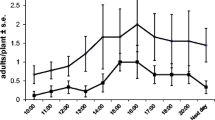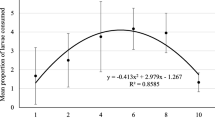Summary
Some of the processes that influence the emigration of prey and predatory mites from bean plants were investigated experimentally. The emigration of the prey depends on the damage they cause to the plants and on predator density. The predator's emigration rate is a decreasing function of prey density, and does not change (or it slightly decreases) when prey and predator numbers are increased maintaining the same prey/predator ratio. The probability of emigration of the predators is independent of their own density when prey are absent and density dependent when prey density is kep constant. Forty three per cent of the variability in the predator's instantaneous rate of emigration in the different experiments is accounted for by a two parameter negative exponential function of capture rate (number of prey eaten per predator and per unit of time).
Similar content being viewed by others
Refereces
Armitage P (1971) Statistical methods in medical research. Blackwell. Oxford
Baker RR (1978) The evolutionary ecology of animal migration. Hodder and Stoughton, London
Bartlett MS (1949) Fitting a straight line when both variables are subject to error. Biometrics 5:207–212
Beddington JR, Free CA, Lawton JH (1978) Characteristics of successful natural enemies in models of biological control of insect pests. Nature 273:513–519
Bernstein C (1981) Dispersal of Phytoseiulus persimilis (Acarina: Phytoseiidae) in response to prey density and distribution. D Phil thesis Oxford University
Bernstein C (1983) some aspects of Phytoseiulus persimilis (Acarina: Phytoseiidae) dispersal behaviour. Entomophaga 28:185–198
Dixon AFG (1973) Biology of aphids. Edward Arnold, London
Draper NR, Smith H (1966) Applied regression analysis. John Wiley and Sons, New York
Everson P (1979) The functional response of Phytoseiulus persimilis (Acarina: Phytoseiidae) to various densities of Tetranychus urticae (Acarina: Tetranychidae). Can Ent 111:7–10
Fernando MHJP (1977) Predation of the glasshouse red spider mite by Phytoseiulus persimilis A-H Ph. D. Thesis, University of London
Fernando MHJP, Hassell MP (1980) Predator prey responses in an acarine system. Res Popul Ecol 22:301–322
Fleschner CA, Badgley ME, Ricker DW, Hall JC (1956) Air drift of spider mites. J Econ Ent 49:624–627
Free CA, Beddington JR, Lawton JM (1977) On the inadequacy of simple models of mutual interference for parasitism predation. J Anim Ecol 46:543–554
Hassell MP (1978) The dynamics of predator-prey systems. Princeton University Press, Princeton
Hassell MP, May RM (1973) Stability in insect host-parasite models. J Anim Ecol 42:693–726
Hassell MP, Varley GC (1969) New inductive population model for insect parasites and its bearing on biological control. Nature 223:1133–1137
Hassell MP, May RM (1974) Aggregation of predators and insect parasites and its effect on stability. J Anim Ecol 43:567–594
Holling CS (1959) Some characteristics of simple types of predation and parasitism. Can Ent 91:385–398
Huffaker CB (1958) Experimental studies on predation II: Dispersion factors and predator-prey oscillations. Hilgardia 27:343–383
Huffaker CB, Shea KP, Herman SG (1963) Experimental studies on predation. Complex dispersion and levels of food in an acarine predator-prey interaction. Hilgardia 34:305–329
Hussey NW, Parr WJ (1963) Dispersal of the glasshouse red spider mite Tetranychus urticae Koch. Entomol exp and appl 6:207–214
Kidd NAC (1982) Predator avoidance as a result of aggregation in the pine aphid, Schizolachnus pineti. J Anim Ecol 51:397–412
Kuno E (1981) Dispersal and the persistence of populations in unstable habitats: A theoretical note. Oecologia (Berlin) 49:123–126
Kuchlein JH (1966) Mutual interference among the predacious mite Typhodiomus longipilus. Nesbitt, Acari Phytoseiidae. I Effects of predator density on oviposition rate and migration tendency. Meded Rijksfac Lanbwet Gent 31:740–746
May RM (1978) Host parasitoid systems in patchy environments: A phenomenological model. J Anim Ecol 47:833–843
Mori H, Chant DA (1966) The influence of prey density, relative humidity and starvation on the predacious behaviour of Phytoseiulus persimilis. Athias-Henriot (Acarina: Phytoseiidae). Can J Zool 44:383–491
Murdoch WW (1977) Stabilizing effects of spatial heterogeneity in predator-prey systems. Theor Pop Biol 11:252–273
Murdoch WW, Oaten A (1975) Predation and population stability Adv Ecol Res 9:2–131
Nachman G (1981) Temporal and spatial dynamics of an acarine predator-prey system. J Anim Ecol 50:435–451
Pimentel D, Nagel WP, Madden JL (1963) Space-time structure of the environment and survival of parasite-hosts systems. Amer Natur 97:141–167
Roitberg BD, Myers JH, Frazer BD (1979) The influence of predators on the movement of apterous pea aphids between plants. J Anim Ecol 48:111–122
Sabelis MW (1981) Biological control of two-spotted spider mites using phytoseiid predators. Part I: Modelling the predator-prey interaction at the individual level. Agric Res Rep Centre for Agricultural Publishing and Documentation, Wageningen
Sih A (1979) Stability and prey behavioral responses to predator density. J Anim Ecol 48:79–89
Sih A (1982). Foraging strategies and the avoidance of predators in an aquatic insect Notomecta Hoffmanni. Ecology 63:786–796
Steel RGD, Torrie JH (1960) Principles and procedures of statistics. Mc Graw-Hill Co, New York
Storms JJH (1971) Some physiological effects of spider mite infestation on bean plants. Neth J PL Path 77:154–167
Takafuji A (1977) The effect of successful dispersal of a phytoseiid mite Phytoseiulus persimilis. Athias-Henriot (Acarina: Phytoseiidae) on the persistence in the interactive system between the predator and its prey. Res Popul Ecol 18:210–222
Takafuji A, Chant DA (1976) Comparative studies of two species of predacious phytoseiid mites (Acarina: Phytoseiidae) special reference to their response to the density of their prey. Res Popul Ecol 17:255–310
Author information
Authors and Affiliations
Rights and permissions
About this article
Cite this article
Bernstein, C. Prey and predator emigration responses in the acarine system Tetranychus urticae-Phytoseiulus persimilis . Oecologia 61, 134–142 (1984). https://doi.org/10.1007/BF00379099
Received:
Issue Date:
DOI: https://doi.org/10.1007/BF00379099




